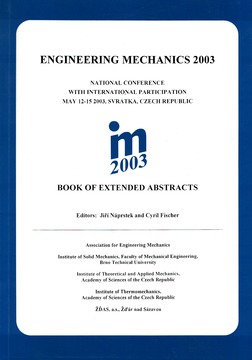Proceedings Vol. 9 (2003)

ENGINEERING MECHANICS 2003
May 11 – 15, 2003, Svratka, Czech Republic
Copyright © 2003 Institute of Theoretical and Applied Mechanics, Academy of Sciences of the Czech Republic, v.v.i., Prague
ISSN 1805-8248 (printed)
ISSN 1805-8256 (electronic)
list of papers scientific commitee
pages 116 - +5p., full text
Abdominal aortic aneurysm is usually manifested like balloon dilation of the distal aorta. This bulge is probably caused by degradation processes in an arterial wall. Sharp cause of this rising of arterial wall is not well known at the present. Mostly is attended by strong atherosclerotic damage of arterial wall. AAA is most often diagnosed below renal arteries. Arterial diameter can overgrow 6 - 7 cm. Adult man mean value of aortal diameter below renal arteries is 2,5 cm. It is seen that growth of aortic abdominal aneurysm can lead to really big values of diameter or to rupture. Presently, there is no reliable criterion to predict the behaviour of AAA and the risk of rupture of abdominal aortic aneurysm. Eighty five percent patients with the rupture AAA is dying. So the risk of rupture of AAA is very grave problem. Most common surgical criterion is based on the values of arterial diameter diameter growth rate only. Indicated to surgery are values of diameter over the 5 cm. But this criterion can not include other important factors as for example arterial mechanics, strength of the wall etc. We suppose that our research will be support for the finding of this prediction criterion and will improve surgery indication. Our method is based on using of artificial neuronal networks. Using this one we try to find response to simply question: Will abdominal aortic aneurysm grow or not? Because in clinical medicine are known situations when AAA stopped its growth. (But never decrease). And using this method we can response second question: How much will aortic diameter increase per time unit. We think that this is the way which is more helpful than other one.
back to list of papers
Text and facts may be copied and used freely, but credit should be given to these Proceedings.
All papers were reviewed by members of the scientific committee.

 Powered by
Imce 3.20 © 2023, Pavel Formánek, Institute of Thermomechanics AS CR, v.v.i. [generated: 0.0247s]
Powered by
Imce 3.20 © 2023, Pavel Formánek, Institute of Thermomechanics AS CR, v.v.i. [generated: 0.0247s]